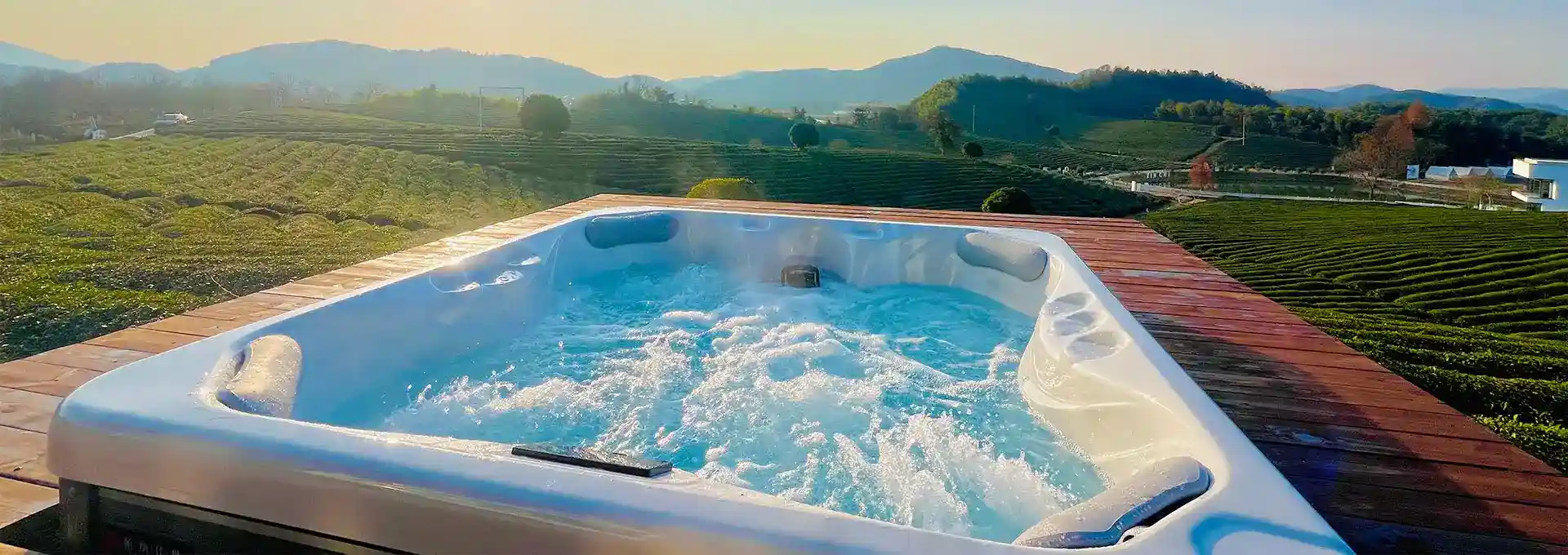How Long Does a Hot Tub Take to Warm Up?
2024-09-13 10:14:15
After a long day, there's nothing quite like sinking into the warm, bubbling waters of a hot tub to unwind and relax. But before you can enjoy this luxurious experience, you need to ensure your hot tub is at the perfect temperature. One question that often comes to mind for hot tub owners or those considering purchasing one is: how long does it take for a hot tub to warm up?
The answer isn't as straightforward as you might think. Several factors can influence the heating time of a hot tub, and understanding these can help you better plan your soaks and maintain your tub efficiently. Let's dive into the details and explore some common questions about hot tub warm-up times and outdoor luxury hot tubs.
What factors affect hot tub heating time?
When it comes to heating a hot tub, several key factors come into play. Understanding these can help you manage your expectations and optimize your hot tub's performance.
1. Initial Water Temperature: The starting temperature of the water in your hot tub is perhaps the most significant factor in determining how long it will take to heat up. If you're filling your tub with cold water from a garden hose, it will naturally take longer to reach your desired temperature compared to starting with warmer water.
2. Desired Temperature: Most people prefer their hot tubs to be between 100°F and 104°F (37.8°C to 40°C). The higher your target temperature, the longer it will take to achieve. It's worth noting that the maximum recommended temperature for hot tubs is 104°F, as higher temperatures can be unsafe.
3. Hot Tub Size and Water Volume: Larger hot tubs with more water will take longer to heat up than smaller ones. This is simply because there's more water to heat. A small 2-person hot tub might heat up in just a few hours, while a large 8-person tub could take significantly longer.
4. Ambient Temperature: The temperature of the surrounding air can have a significant impact on heating time, especially for outdoor hot tubs. In colder climates or during winter months, your hot tub will have to work harder to reach and maintain the desired temperature.
5. Cover Quality: A well-insulated, high-quality hot tub cover can make a big difference in heating time and energy efficiency. It helps retain heat and prevents heat loss, especially in colder environments.
6. Heater Power: The power of your hot tub's heating element, typically measured in kilowatts (kW), directly affects how quickly it can heat the water. More powerful heaters will naturally warm the water faster.
7. Insulation: The quality of your hot tub's insulation plays a crucial role in both heating time and energy efficiency. Well-insulated tubs retain heat better, reducing the time and energy needed to maintain the desired temperature.
8. Jet Usage: While jets can make your hot tub experience more enjoyable, running them during the heating process can actually slow things down. Jets introduce cooler air into the water, which can lower the overall temperature.
Given all these factors, on average, you can expect a hot tub to heat up at a rate of 3-6°F per hour. This means that if you're starting with 68°F tap water and want to reach 100°F, it could take anywhere from 5 to 10 hours. However, this is just a general estimate, and your actual heating time may vary based on the factors mentioned above.
How can I speed up my hot tub's warm-up process?
While patience is key when it comes to heating a hot tub, there are several strategies you can employ to optimize the warm-up process:
1. Use a High-Quality Cover: Investing in a well-insulated, snug-fitting cover is one of the most effective ways to speed up heating and maintain temperature. When not in use, always keep your hot tub covered to prevent heat loss.
2. Pre-plan Your Soaks: If you know you'll want to use your hot tub at a specific time, plan ahead and start heating it well in advance. Many modern hot tubs come with smart features that allow you to schedule heating cycles.
3. Maintain a Consistent Temperature: Instead of letting your hot tub cool down completely between uses, consider maintaining a base temperature a few degrees below your ideal soaking temperature. This approach can significantly reduce heating time and may even save energy in the long run.
4. Use Warm Water for Filling: If you're filling your hot tub for the first time or after cleaning, use warm water instead of cold. This can give you a head start on the heating process.
5. Shelter Your Hot Tub: For outdoor hot tubs, providing some form of shelter – like a gazebo or strategically placed landscaping – can help shield it from wind and extreme temperatures, potentially reducing heating time.
6. Regular Maintenance: Keep your hot tub clean and well-maintained. A clean filter and well-balanced water can help your heater work more efficiently.
7. Upgrade Your Heater: If your hot tub is older, consider upgrading to a more powerful or energy-efficient heating system. Modern heaters can significantly reduce warm-up times.
8. Use a Floating Thermal Blanket: In addition to your regular cover, a floating thermal blanket can provide an extra layer of insulation, reducing heat loss from the water's surface.
Remember, while it's natural to want to enjoy your hot tub as quickly as possible, the heating process shouldn't be rushed too much. Trying to heat water too quickly can put unnecessary strain on your equipment and may lead to increased energy consumption.
Are outdoor luxury hot tubs energy-efficient?
When considering an outdoor luxury hot tub, energy efficiency is often a key concern for potential buyers. The good news is that modern luxury hot tubs are designed with energy efficiency in mind, incorporating various features and technologies to minimize energy consumption while maintaining optimal performance.
1. Advanced Insulation: High-end outdoor hot tubs often feature multi-layer insulation systems. This might include full-foam insulation, which fills the cabinet space with insulating foam, or a combination of different insulating materials strategically placed to maximize heat retention. Some manufacturers use recycled and eco-friendly materials for insulation, adding to the tub's overall sustainability.
2. Energy-Efficient Pumps: Luxury hot tubs often come equipped with variable-speed or two-speed pumps. These pumps can operate at lower speeds for filtration and heating, consuming less energy, and then ramp up to higher speeds when jets are in use. This flexibility allows for significant energy savings during routine operation.
3. Smart Heating Systems: Many outdoor luxury hot tubs now incorporate smart heating technologies. These systems can learn your usage patterns and adjust heating cycles accordingly. For example, if you typically use your hot tub in the evenings, the system will ensure it's up to temperature by then while conserving energy at other times.
4. LED Lighting: While not directly related to heating, the use of LED lighting in luxury hot tubs contributes to overall energy efficiency. LED lights consume far less power than traditional bulbs and have a much longer lifespan.
5. High-Quality Covers: Luxury hot tubs often come with premium, well-fitted covers. These covers are typically thicker and better insulated than standard ones, significantly reducing heat loss when the tub is not in use.
6. Circulation Pumps: Some high-end models feature dedicated circulation pumps. These low-wattage pumps run continuously to filter and heat the water more efficiently than using the main pump at low speed.
7. Energy-Efficient Jets: The design and placement of jets in luxury hot tubs are often optimized for both performance and energy efficiency. Some models allow you to direct power to specific jet zones, reducing overall energy consumption when full power isn't needed.
8. Smart Controls: Many luxury hot tubs come with smart control systems that allow you to monitor and adjust your hot tub's settings remotely. This means you can optimize energy usage even when you're away from home.
9. Heat Recovery Systems: Some advanced models incorporate heat recovery systems that capture and reuse the heat generated by the pump motors, further improving overall energy efficiency.
10. Weather-Adaptive Technology: Certain high-end outdoor hot tubs feature technology that adapts to weather conditions. For instance, they might adjust heating cycles based on outdoor temperature and humidity levels to maintain efficiency.
While these features contribute to the energy efficiency of outdoor luxury hot tubs, it's important to note that the actual energy consumption can vary based on usage patterns, climate, and how well the tub is maintained. Regular maintenance, proper use of the cover, and mindful temperature management can all help maximize the energy efficiency of your luxury hot tub.
Moreover, many manufacturers of luxury hot tubs are now focusing on overall sustainability, not just energy efficiency. This might include using recycled materials in construction, implementing water-saving features, or even incorporating solar-powered components in some models.
In conclusion, while the initial warm-up time for a hot tub can vary depending on several factors, modern outdoor luxury hot tubs are designed to heat efficiently and maintain temperature with minimal energy waste. By understanding the factors that affect heating time and implementing strategies to optimize the process, you can ensure that your hot tub is ready when you are, providing a luxurious and relaxing experience without excessive energy consumption. Whether you're a current hot tub owner or considering purchasing one, the energy efficiency and smart features of today's luxury models make them an attractive option for those seeking both comfort and sustainability in their outdoor relaxation space.
For more information on hot tub installations and to find out more about our products, please feel free to contact us at info@iparnassus.com.
References:
1. Energy.gov. (2022). "Energy-Efficient Home Design."
2. Hot Spring Spas. (2023). "How Long Does It Take a Hot Tub to Heat Up?"
3. Bullfrog Spas. (2023). "Hot Tub Heating Guide: Time, Temperature & Energy Efficiency."
4. Master Spas. (2022). "How to Heat a Hot Tub Faster."
5. Swim University. (2023). "How to Heat a Hot Tub Faster (9 Simple Tips)."
6. Hot Tub Owner HQ. (2023). "How Long It Takes For A Hot Tub To Heat Up (And How To Speed It Up)."
7. River Pools and Spas. (2022). "How Long Does It Take a Hot Tub to Heat Up? (Warmup Times and Tips)"
8. The Cover Guy. (2023). "Energy Efficiency in Modern Hot Tubs."
9. Caldera Spas. (2023). "Energy Efficient Hot Tubs: How to Save on Energy Costs."
10. Jacuzzi. (2023). "Energy Efficiency and Hot Tubs: What You Need to Know."



